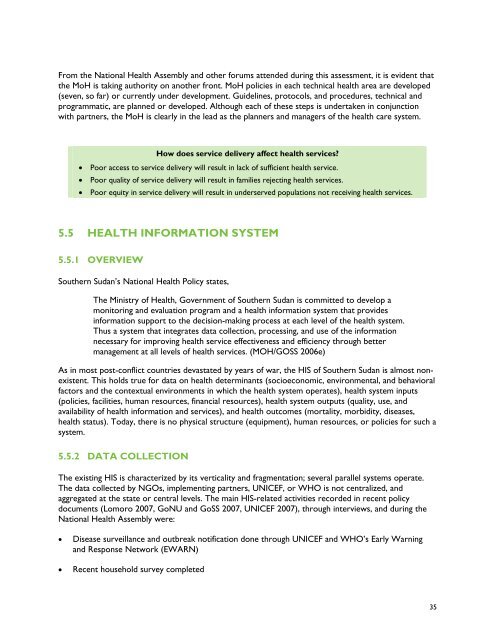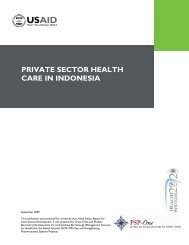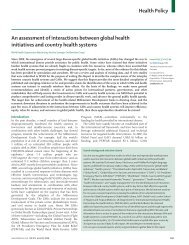southern sudan health system assessment - Health Systems 20/20
southern sudan health system assessment - Health Systems 20/20
southern sudan health system assessment - Health Systems 20/20
Create successful ePaper yourself
Turn your PDF publications into a flip-book with our unique Google optimized e-Paper software.
From the National <strong>Health</strong> Assembly and other forums attended during this <strong>assessment</strong>, it is evident that<br />
the MoH is taking authority on another front. MoH policies in each technical <strong>health</strong> area are developed<br />
(seven, so far) or currently under development. Guidelines, protocols, and procedures, technical and<br />
programmatic, are planned or developed. Although each of these steps is undertaken in conjunction<br />
with partners, the MoH is clearly in the lead as the planners and managers of the <strong>health</strong> care <strong>system</strong>.<br />
How does service delivery affect <strong>health</strong> services<br />
• Poor access to service delivery will result in lack of sufficient <strong>health</strong> service.<br />
• Poor quality of service delivery will result in families rejecting <strong>health</strong> services.<br />
• Poor equity in service delivery will result in underserved populations not receiving <strong>health</strong> services.<br />
5.5 HEALTH INFORMATION SYSTEM<br />
5.5.1 OVERVIEW<br />
Southern Sudan’s National <strong>Health</strong> Policy states,<br />
The Ministry of <strong>Health</strong>, Government of Southern Sudan is committed to develop a<br />
monitoring and evaluation program and a <strong>health</strong> information <strong>system</strong> that provides<br />
information support to the decision-making process at each level of the <strong>health</strong> <strong>system</strong>.<br />
Thus a <strong>system</strong> that integrates data collection, processing, and use of the information<br />
necessary for improving <strong>health</strong> service effectiveness and efficiency through better<br />
management at all levels of <strong>health</strong> services. (MOH/GOSS <strong>20</strong>06e)<br />
As in most post-conflict countries devastated by years of war, the HIS of Southern Sudan is almost nonexistent.<br />
This holds true for data on <strong>health</strong> determinants (socioeconomic, environmental, and behavioral<br />
factors and the contextual environments in which the <strong>health</strong> <strong>system</strong> operates), <strong>health</strong> <strong>system</strong> inputs<br />
(policies, facilities, human resources, financial resources), <strong>health</strong> <strong>system</strong> outputs (quality, use, and<br />
availability of <strong>health</strong> information and services), and <strong>health</strong> outcomes (mortality, morbidity, diseases,<br />
<strong>health</strong> status). Today, there is no physical structure (equipment), human resources, or policies for such a<br />
<strong>system</strong>.<br />
5.5.2 DATA COLLECTION<br />
The existing HIS is characterized by its verticality and fragmentation; several parallel <strong>system</strong>s operate.<br />
The data collected by NGOs, implementing partners, UNICEF, or WHO is not centralized, and<br />
aggregated at the state or central levels. The main HIS-related activities recorded in recent policy<br />
documents (Lomoro <strong>20</strong>07, GoNU and GoSS <strong>20</strong>07, UNICEF <strong>20</strong>07), through interviews, and during the<br />
National <strong>Health</strong> Assembly were:<br />
• Disease surveillance and outbreak notification done through UNICEF and WHO’s Early Warning<br />
and Response Network (EWARN)<br />
• Recent household survey completed<br />
35
















